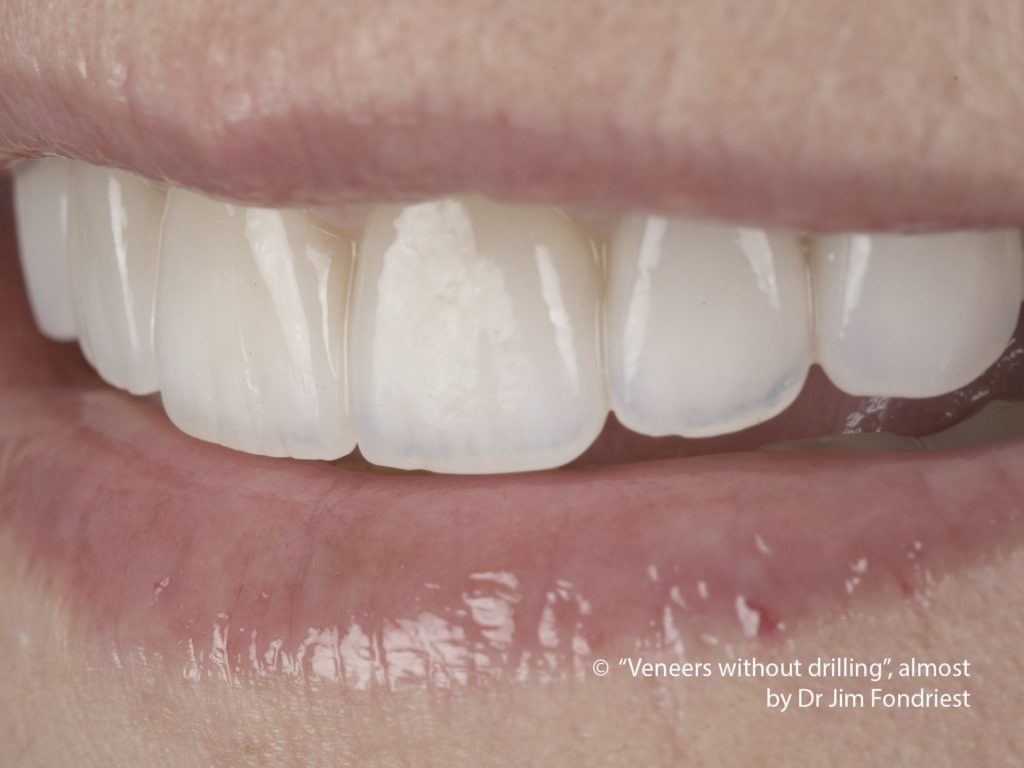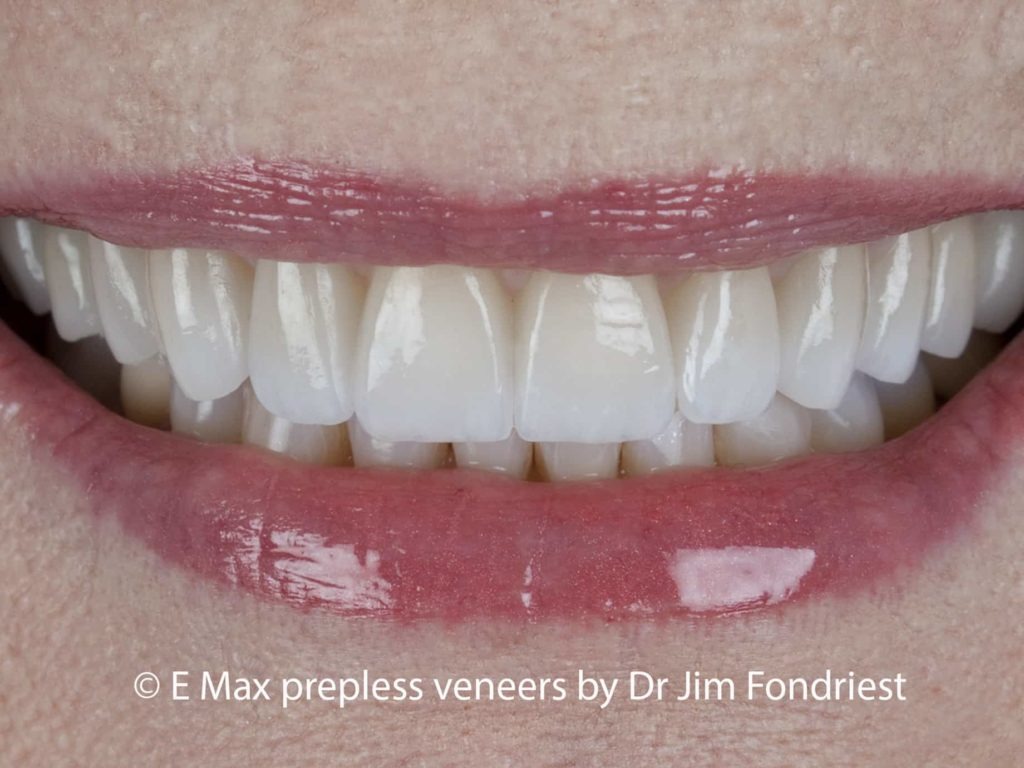Veneers without drilling

These veneers were done without drilling. Just as with dental bonding, we can now change tooth shapes and cover stains without drilling. A type of E Max porcelain has been developed that is strong and can create a natural smile.
Teamed with world famous Master Ceramist Matt Roberts CDT, our office is proud to announce the development of no drill veneers. This advancement in cosmetic dental treatment allows trained dentists to do veneers without drilling on the teeth.
It is now possible because of a new porcelain that has been developed. This is the newest most advanced porcelain in the world today. It was created to be used for veneers that can be made as thin as 0.2mm. These ultra-thin ceramics are very strong and durable. Unlike old technology Durathin veneers, this ceramic looks exactly like enamel.
A less brittle porcelain
Most porcelains are extremely brittle. Regular veneers as thick as 0.5mm will easily break during the bonding process. This new non-brittle lithium disilicate porcelain can be made in very thin sheets that bond without cracking. This allows the healthy natural tooth to be maintained. In many cases, no Novacaine is required to create these beautiful restorations.
Veneers without drilling for healthier teeth

Smile makeovers are no longer solely done for young people. Now we are finding more elective cosmetic cases are on women over the age of 60. This patient always wanted a beautiful smile and finally at age 77, asked for it! Most of her upper teeth were covered. We created the contours that this very sophisticated client from Chicago’s Gold Coast requested. She had worn teeth due to nighttime tooth grinding. See her Before and after photos
Many patients are uneasy and hesitant about having any tooth structure removed, especially when the teeth are in a healthy condition. Low preparation or no prep veneers offer the conservatism of bonded composite veneers while delivering the durability and beauty of regular versions. These paper thin ceramic sheets are like contact lenses. They allow the normal color of the natural enamel to come through while covering the blemishes.
What determines how much drilling is needed to do a dental veneer?
Not all cosmetic dentists do the same amount of planning prior to doing your makeover. The amount of tooth reduction should be thoroughly planned out. We spend a great deal of time determining the exact amount of drilling if any is needed to reach your goals.
There are positives and negatives with both heavy and light enamel removal which significantly affect the quality of outcome. A veneer without drilling is a good choice when modest improvement in symmetry and tooth alignment is desired. It is also perfect for making a more uniform tooth surface.
The best cases for veneers without drilling are those without spaces between the teeth and no gum recession. They are not a good choice when the goal is to change the brightness of the teeth. When ultra-thin veneers are planned, tooth bleaching is commonly done first.
When the candidate for no prep veneers is not ideal, minimally invasive dentistry can be more challenging for the doctor and the ceramist than with the regular designs. The dentist is responsible for controlling undercuts, creating a line of draw, and hiding margins. Big improvements in outcome can be achieved with very small amounts of drilling.
Temporaries are not required

This patient had ten upper front teeth done with only a small amount of enamel removal. They were done to lengthen them and to fill the gaps or spaces between her teeth and to broaden her smile.
There are other reasons why you would want to choose veneers with no drilling. You will have a shorter appointment. Novacaine is no longer required. The fact that no or limited enamel is removed means temporaries are not required.
Although accurate impressions are just as critical with no prep dentistry, the invasiveness and difficulty of the impression is less. With less drilling, there is more tooth enamel, which increases the strength of the bond. This makes the prepless veneers stronger and last longer.
Advantages of traditional porcelain veneers over no drill versions
- The more you want the tooth shapes and positions changed, more drilling is needed
- Better control of midline alignment
- Making the teeth whiter is easier
- The front surface contours are less bulky, especially on the eye teeth
- It is easier for the dentist to place the restorations with multiple lines of draw
- Less technique sensitive for the dentist and technician
- Easier to hide margins or the edges of the restorations long term
- More symmetrical shapes, especially of lateral incisors
- Nicer surface textures
- Nicer incisal characterization
- The smile design process is easier with traditional veneers
- Both types offer a chance for a perfect smile
Learn more about the possibilities with minimal tooth preparation veneers as a treatment option
If your teeth are healthy, veneers will be better than crowns. We have never had a client who was sad that they took the journey of getting minimal preparation for cosmetic dentistry.
To better oral health!
Drs. Fulreader and Fondriest are Nationally recognized and highly sought after cosmetic dentists serving clients from throughout the United States
